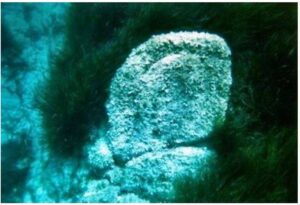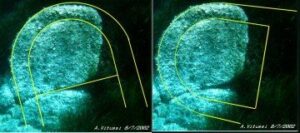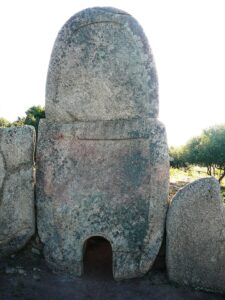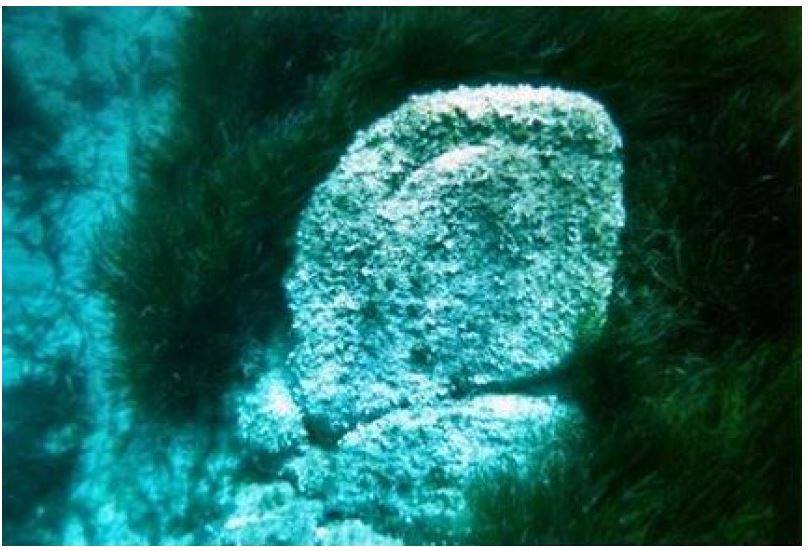In the distant month of September 2003, my friend Andrea Vitussi proposed some interesting observations regarding the discovery, on the seabed of the Maddalena archipelago, of a particularly unique lithic element: “I take inspiration from one of my excursions in the North-East part of Sardinia, and more precisely the Maddalena archipelago. As is known, this island complex extends in the Tyrrhenian area between Sardinia and Corsica. In particular, the area in question is the coasts of the island “La Maddalena”, a geological complex predominantly made up of biotite granite [an intrusive volcanic rock mainly composed of quartz, potassium feldspar (orthoclase, microcline), plagioclase (albite-oligoclase), biotite mica]. During the snorkeling exploration of the rocky seabed, I caught sight of a flattened stone block that drew my attention…. The block was located at a depth of about 5-6 meters, resting among other blocks in a spot where the topography of the bottom suggested a hollow [with the bottom now covered in sand] between other massive rock structures. Upon closer examination, it seems to resemble in structure one of the many shaped and engraved slabs belonging to the funerary complexes of the island Sardinia known as “Tombe dei Giganti”: its dimensions, thickness, pseudo-rectangular shape, the rounding of the corners, and the engraving [undoubtedly artificial] that reproduces the arched motif present in the central slab of the nuragic funerary complexes.
During the snorkeling exploration of the rocky seabed, I caught sight of a flattened stone block that drew my attention…. The block was located at a depth of about 5-6 meters, resting among other blocks in a spot where the topography of the bottom suggested a hollow [with the bottom now covered in sand] between other massive rock structures. Upon closer examination, it seems to resemble in structure one of the many shaped and engraved slabs belonging to the funerary complexes of the island Sardinia known as “Tombe dei Giganti”: its dimensions, thickness, pseudo-rectangular shape, the rounding of the corners, and the engraving [undoubtedly artificial] that reproduces the arched motif present in the central slab of the nuragic funerary complexes. There are details that have directed my attention to identify in it an artifact created by human hands, perhaps connected to the nuragic civilization… For a nearly uninitiated person like myself, spontaneous questions arise: Why is such a find located below sea level? Is it possible that it is indeed a fragment of “Tomba dei Giganti”? If so, it would be an interesting fact, since, as far as I know, traces of ancient Neolithic settlements and other artifacts dating back to periods up to the Bronze Age have been found, but I have not yet found texts related to these locations that mention tombs of the nuragic type. Not only that, but from an axiom I have accepted by common convention, it seems that the period of appearance of these “nuragic” structures should date back to 1600-1800 BC. At this point, it seems curious to me that an artifact of this kind [provided it has remained underwater from the origin] could date back to periods when the sea was still at low levels, that is, at the end of the last glaciations [which, according to geologists – read my brother – should have left that stretch of seabed dry more than 2000 years BC].
There are details that have directed my attention to identify in it an artifact created by human hands, perhaps connected to the nuragic civilization… For a nearly uninitiated person like myself, spontaneous questions arise: Why is such a find located below sea level? Is it possible that it is indeed a fragment of “Tomba dei Giganti”? If so, it would be an interesting fact, since, as far as I know, traces of ancient Neolithic settlements and other artifacts dating back to periods up to the Bronze Age have been found, but I have not yet found texts related to these locations that mention tombs of the nuragic type. Not only that, but from an axiom I have accepted by common convention, it seems that the period of appearance of these “nuragic” structures should date back to 1600-1800 BC. At this point, it seems curious to me that an artifact of this kind [provided it has remained underwater from the origin] could date back to periods when the sea was still at low levels, that is, at the end of the last glaciations [which, according to geologists – read my brother – should have left that stretch of seabed dry more than 2000 years BC]. On this subject, a document by G. Bulciolu (…) that deals with the proto-history of the archipelago and human settlements, as well as the archeo-geographical hypotheses for the area in question, seemed significant to me. Some of the statements contained therein could provide a partial answer to some questions. In fact, I quote verbatim the last sentence of the article: <<the sea today preserves most of the testimonies of this era and perhaps many others as well. Today, at a depth of only 20 meters, thousands of years ago at sea level, man lived and progressed thanks to simple stone flakes>>. From a recent study by Dr. Emma Blake…. on the spatial arrangement of Sardinian archaeological sites pertaining to the Bronze Age, it emerges that the diffusion of the nuraghi on the island is statistically accompanied by the presence of megalithic tomb complexes, the so-called “Tombe dei Giganti” or “Gigantinu”. Based on the data collected during the survey campaigns of 1996, 1997, 1998 for her doctoral research, Dr. Blake highlighted how the spatial parameters of interrelation between the two types of structures are almost homogeneous.
On this subject, a document by G. Bulciolu (…) that deals with the proto-history of the archipelago and human settlements, as well as the archeo-geographical hypotheses for the area in question, seemed significant to me. Some of the statements contained therein could provide a partial answer to some questions. In fact, I quote verbatim the last sentence of the article: <<the sea today preserves most of the testimonies of this era and perhaps many others as well. Today, at a depth of only 20 meters, thousands of years ago at sea level, man lived and progressed thanks to simple stone flakes>>. From a recent study by Dr. Emma Blake…. on the spatial arrangement of Sardinian archaeological sites pertaining to the Bronze Age, it emerges that the diffusion of the nuraghi on the island is statistically accompanied by the presence of megalithic tomb complexes, the so-called “Tombe dei Giganti” or “Gigantinu”. Based on the data collected during the survey campaigns of 1996, 1997, 1998 for her doctoral research, Dr. Blake highlighted how the spatial parameters of interrelation between the two types of structures are almost homogeneous. The distances between the nuraghe and the associated tombs are always greater than 100 meters and less than 500, and in the original layout, the visibility of each structure from the other was guaranteed in 91% of cases. 86% of the funerary structures have their major axis aligned with the South-East direction and predominantly follow the axis of the nearest nuragic tower. Lastly, as a final data point, observations count 62% of cases where the tombs are located at a lower altitude than the reference nuraghe… With this information available, one could aim investigations on the seabed to ascertain not only the true nature of the find but also the possible identification of other blocks belonging to the burial structure, as well as the presence of other remains connected to it. I have no idea if Andrea’s extraordinary testimony had a follow-up, but there is no doubt that the continuous archaeological discoveries that characterize the entire regional territory, to which we are somewhat accustomed, are complemented by a heritage, equally unexplored, held by the waters surrounding our coasts.
The distances between the nuraghe and the associated tombs are always greater than 100 meters and less than 500, and in the original layout, the visibility of each structure from the other was guaranteed in 91% of cases. 86% of the funerary structures have their major axis aligned with the South-East direction and predominantly follow the axis of the nearest nuragic tower. Lastly, as a final data point, observations count 62% of cases where the tombs are located at a lower altitude than the reference nuraghe… With this information available, one could aim investigations on the seabed to ascertain not only the true nature of the find but also the possible identification of other blocks belonging to the burial structure, as well as the presence of other remains connected to it. I have no idea if Andrea’s extraordinary testimony had a follow-up, but there is no doubt that the continuous archaeological discoveries that characterize the entire regional territory, to which we are somewhat accustomed, are complemented by a heritage, equally unexplored, held by the waters surrounding our coasts.

